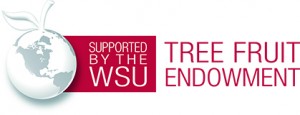Integrated Pest Management
Integrated pest management (IPM) involves using several control strategies based on knowledge of a crop, its pests and their associated natural enemies to avoid crop loss and minimize harmful effects on the environment. Implementing IPM requires an understanding not only of insect and mite biology and ecology, but also knowledge of the entire orchard system. This includes the plants and animals that comprise the orchard community, as well as consideration of contributions from the surrounding habitat. The ‘orchard system’ also takes into account financial, physical and human aspects of orchard operations.
Seasonal insect and disease control requires adequate monitoring, properly timed control and appropriate choice of cultural, insecticidal and biological controls. The WSU Decision Aid System (WSU-DAS) is an online tool that assists with control efforts through the use of insect, mite and disease models that help to predict when pests are best controlled along with providing assistance with choosing an appropriate recommendation for your situation. The Crop Protection Guide for Tree Fruits is another resource that offers the latest options in control for commercial orchards.
Proper monitoring requires an understanding of pest/disease biology and protocols for trapping. Monitoring techniques and insect/mite information are included in the online Orchard Pest Management book. The Pest Management Transition Handbook is no longer available online.
Thanks to WSU research, IPM continues to evolve. In a global marketplace, it is inevitable that new pests will invade. But as they do, scientists continue to find new control techniques. And that’s a good thing for the Washington tree fruit industry, because consumers’ concerns over insecticide residues on food, contamination of the environment, and exposure of farm workers to insecticide residues during thinning, tree training, and harvesting operations are issues of increasing importance. IPM addresses each of these concerns.
